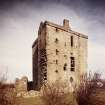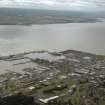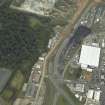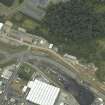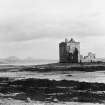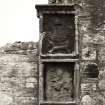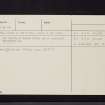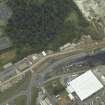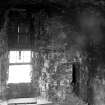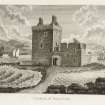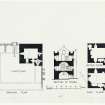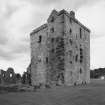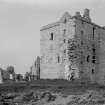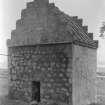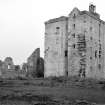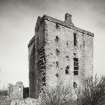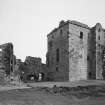Rosyth Castle
Tower House (Medieval)
Site Name Rosyth Castle
Classification Tower House (Medieval)
Canmore ID 50938
Site Number NT18SW 20
NGR NT 10870 82098
Datum OSGB36 - NGR
Permalink http://canmore.org.uk/site/50938
- Council Fife
- Parish Dunfermline
- Former Region Fife
- Former District Dunfermline
- Former County Fife
NT18SW 20.00 10870 82098
NT18SW 20.01 11023 82233 Dovecot
(NT 1087 8210) Rosyth Castle (NR) (Remains of)
OS 6" map (1946)
Rosyth Castle: The remains consist of a rectangular enclosure of 16th and 17th century date abutting at the NE angle on a late 15th century tower. The tower was originally attached to a lofty barmkin, 40' - 50' high, which was replaced by the enclosure walls with a series of lower structures against the inner sides. The enclosed area was 60' N-S by 72' E-W.
The S range is destroyed, while only the foundations remain of the S ends of the E and W ranges. Sufficient of the N range is left to indicate that it comprised a vaulted ground floor and two upper floors surmountd by a parapet walk. The entrance is in the N range. The tower is 58' high by 41' by 48' over walls 10' thick. A small wing projects at the SE angle. The masonry is ashlar. Traces of the original barmkin, higher on the W face, remain on the walls.
RCAHMS 1933
The remains of Rosyth Castle are as described.
Visited by OS (DWR) 18 February 1974
NT18SW 20.00 10870 82098
NMRS REFERENCE:
Stands on the margin of the North shore of the Forth and about three miles or so from Dunfermline. It is a huge square turret, now deserted, and the property of the Earl of Hopetoun. The 'Uncatalogued MSS of General Hutton' held in the National Library of Scotland, gives a Sketch of the Castle (number 24) Vol.1
EXTERNAL REFERENCE:
Edinburgh Public Library
James Grant Sketch Book. Nos. 336-338
Field Visit (8 June 1928)
Rosyth Castle.
Until recent years this castle stood on a small island, little more than an outcrop of rock accessible at low tide, on the foreshore of St. Margaret's Hope. The reclamation of land in connection with the Admiralty Dockyard, has, however, brought the site well inland. The existing remains are those of a rectangular enclosure of 16th- and 17th-century date abutting at the north-east angle on a late 15th-century tower, which, though slightly altered, is complete and in much better condition than the rest of the buildings. The tower had originally been attached to an unusually lofty barmkin, 40 to 50 feet in height, which was demolished, probably to gain light and air, when the walls of the later enclosure were erected with a series of lower structures resting against their inner sides. The south range is entirely destroyed, while the east and west ranges are represented at their southern ends merely by foundations, and are elsewhere extremely ruinous. Of the north range, however, sufficient is left to indicate that it comprised a vaulted ground-floor and two upper floors and was surmounted by a parapet-walk, terminating at the north-west angle in a roundand at the eastern end against the tower. The enclosed area has measured 60 feet from north to south by 72 feet from east to west.
The entrance is in the north range and opened into a transe, which was in all likelihood once vaulted. The gateway is set forward and may be rather later than the walling behind. In the angles of the projection are gun-loops, while other gun-loops are set in the lower part of the outer wall of the enclosure. Above the gate are two armorial panels. The lower, enclosed by a plain moulded border is wholly illegible. The upper, more elaborately framed, contains within a garland, flanked by the initials M(ARIA) R(EGINA), each below a crown, the Royal Arms of Scotland ensigned with a crown, beside which is the date 1561. Below the garland is a unicorn couchant. At the level of the panels, beside the old tower, are the remains of a turret-stair, which rose from the first to the upper floor, the former being probably reached by a forestair within the enclosure. In the 17th century a turnpike, rising from the ground, was built against the east gable of the south range, but only portions of its foundations have survived. On the east side of the entrance is a small chamber and there are three chambers to the west, all mainly of the 16th century, but a fourth chamber on the western side of the courtyard is of 17th-century date.
The old tower, standing to a height of 58 feet, measures 41 feet 6 inches by 48 feet 3 inches over walls which are 10 feet thick, while a small wing projects southwards from the south-east angle to give additional room for a spacious turnpike. The masonry is ashlar of excellent quality, in contrast to the I6th-centurybuilding, and has weathered well. The windows, where unaltered, are narrow and are chamfered at jamb and lintel. The parapet, which has a slight overhang but no moulded corbel-course, is returned round the building, except on the gable and west wall of the wing. On the walls there still remain traces of the original barmkin. These are at a higher level on the western face, where its parapet-walk communicated with the second floor of the tower, than on the southern one where it simply abutted on the wing.
The entrance is in the angle at the north-east corner of the courtyard. The doorway has a chamfered segmental head and is fitted for two doors, both opening inwards into a small lobby. On the right of the lobby is the staircase to the upper floors and immediately in front is the main apartment of the ground floor, above which there is an entresol. This apartment has been ceiled in wood, as is shown by the corbels for the joists on the side walls, and at first the only light seems to have come from the door, as the small window beside the door has been inserted later. Clearly it must have been a storeroom. The entresol, which was also used as a storeroom, was reached originally by a ladder, but latterly by a service-stair descending from the hall above it. It is ceiled with a segmental barrel-vault and is lit from each gable.
The hall is entered from the main staircase, and since the 17th century it has been a lofty chamber with a barrel-vaulted ceiling. Previously there had been an entresol below the vault. At that time the windows were small, as can be seen from an example which remains in the north wall, though the seats in the embrasure have been removed. Beside this window is a wall press. The removal of the entresol in the 17th century allowed of a tall window with mullion and transoms being inserted in each gable to replace the original lights. The lower divisions of these windows were shuttered, the upper ones glazed. On the outside face of the lowest transom on the west is the inscription, I.S. M.N. 1635, for James Stewart of Rosyth and Margaret Napier, his wife. In the south wall is the fireplace, which was enlarged in the 17th century and has a locker in the west jamb. A mural chamber on the same side provided the necessary connection with the staircase. Beside the latter, but in the thickness of the east wall, is another chamber, from which the service-stair, spoken of above, led to the entresol of the ground floor. A third mural chamber, probably a garderobe, has apparently been built up on the north side of the east window. Beside the west window is a doorway, now filled in which communicated with the first floor of the 16th-century buildings.
The main stair formerly rose from the ground to the top of the tower. On the way up, at about the level of the higher of the two entresols, there is a garderobe in the east gable, provided with a seat and a basin with outlet. Beyond the first floor the steps have disappeared, and the ascent has to be continued by a ladder. On the second floor is a solar lit from north, south and east, the eastern window having a three-sided rear-arch. The solar is entered through a window embrasure, in the breast of which is a fitted basin. At the north-west angle of the room, near the fireplace, is a vaulted mural chamber, which once gave access to the parapet walk of the original barmkin. In the north-east angle is a garderobe. In the south wall is another mural chamber which was entered from the staircase, but did not communicate with the main apartment. The ceiling of the solar has been of timber, and the side walls bear a heavy continuous corbel-course of a type which has not been noticed in previous Inventories, although a similar construction is found in the Palace at Dunfermline (p. 120). Above lay a garret, evidently a habitable room when entire, though now roofless. The parapet-walks have the unusual width of 7 feet.
HISTORICAL NOTE. In 1428 the King granted and confirmed to Sir David Stewart his barony of Rosyth which Stewart had resigned along with other lands in order that the whole might be united in one barony (1). Sir David is said to have been a patron of Walter Bower, Abbot of Inchcolm, whom he encouraged in the compilation of the Scotichronicon (2). Rosyth remained with this family till the failure of male descendants towards the close of the 17th century.
RCAHMS 1933, visited 8 June 1928.
(1) Reg. Mag. Sig., s.a., No. 115. (2) Prefatio, by Walter Goodall to edition. of 1759, p. iii. Cf. also Cast. and Dom. Arch., i, p. 289.
Note (July 2017)
Rosyth Castle
Located on the shores of the Firth of Forth in St Margaret's Hope, Fife, Rosyth Castle was built around 1450 as the residence of Sir David Stewart who had been granted the Barony of Rosyth in 1428 by James I of Scotland. The castle remained in the Stewart family until the late 17th century. One of the windows still bears the date 1635 and the initials I. S. M. N for James Stewart and his wife Margaret Napier.
The castle was built on a small island with access from the north by a causeway which was submerged at high tide. It was a fortified residence consisting of a tower house in an L-plan standing nearly 20 meters tall with thick walls, originally surrounded by an unusually tall barmkin (a defensive enclosure). Features such as gun-loops can still be seen. The courtyard within the enclosure would have contained the domestic buildings including stables, brewhouse and bakehouse. A well preserved dovecot can still be seen to the north of the castle. The original tower house was later enlarged and extended in the 16th and early 17th centuries. An armorial panel includes the initials M R for Maria Regina, each below a crown and the date 1561.
Rosyth Castle came into the possession of the Earl of Hopetoun and remained in that family until 1903. It had been unoccupied since the 18th century and stonework was reused in other structures. In time the courtyard buildings were almost raised to the ground, leaving only the tower and north courtyard wall which can still be seen today.
The HES archive offers a fascinating glimpse into the later history of Rosyth Castle and its surroundings. As well as illustrations from artists, photographers and antiquarians, the archive also shows how the castle’s surroundings were shaped by events in the 20th century.
One of the earliest depictions of Rosyth Castle in the HES archive is an engraving from the late 18th century by D B Pyet showing the castle surrounded by water with sailing ships on the Forth. In 1834 it was drawn by the amateur artist Alexander Archer who illustrated its prominent position on the Forth as well as the increasingly ruinous state of the building. The artist and antiquarian James Drummond captured the castle in 1857 showing in the background the surrounding landscape in Fife, with only a few other buildings visible.
Around 1880 the castle was photographed by Erskine Beveridge showing it surrounded by water. A similar view of the castle at low tide is included in a photograph album from around 1900 which also shows the first signs of change in the area with the new Forth Bridge visible in the distance.
Rosyth Castle after 1903
In 1903 the land around the castle became the property of the Admiralty for a new naval base at Rosyth. A contemporary historian, Alan Reid, wrote about the project and how it was likely to change this corner of Fife but 'let us again express wide-spread hope and desire that, come whatever transformation may over the beauteous surroundings of the solitary castle, its place and function as a striking central object may be preserved, and a position of honour assigned it among the administrative or domestic buildings of the Base'.
Work started on the naval base in 1909, and the castle was originally intended to have been converted into a library and reading room for the Royal Navy Officers stationed there but with the outbreak of the First World War in 1914 this plan was postponed. The remains of the castle were not significantly altered but its position in the landscape changed beyond all recognition. Throughout its history the castle had only been accessible at low tide but as a result of land reclamation it lost its waterfront position and became surrounded by the naval base, with its railways, cranes, power station, dry docks and other features.
The base was in use during the First World War but was largely closed by 1925. Photographers from the Office of Works photographed the castle in 1927 showing some of the new buildings surrounding it, and it was recorded in detail for the Inventory of monuments and constructions in the counties of Fife, Kinross, and Clackmannan, published by RCAHMS in 1933.
The naval base was reopened in 1938 and was in use during the Second World War. An aerial photograph taken by the Royal Air Force in 1941 shows the castle (bottom left) next to a large camouflaged building. In the dry docks HMS Prince of Wales is under repair and several military installations including heavy anti-aircraft batteries can be seen as well as the new housing in the town of Rosyth.
The site continued to expand and was the location chosen to refit the Royal Navy's nuclear submarine fleet, and today it is involved in the construction of HMS Queen Elizabeth-class carriers. From 1993 large parts of the site were sold off and the land the castle stands on is now in private hands situated at a corner of the security enclosure for the commercial port.
Kristina Watson – Archivist, Historic Environment Scotland




































![View of Rosyth Castle on island.
Original envelope annotated by Erskine Beveridge 'Rosyth Cas[tle]'.](http://i.rcahms.gov.uk/canmore/l/SC01129268.jpg)






















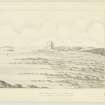
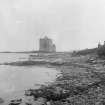
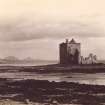
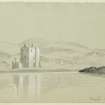
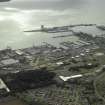
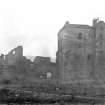
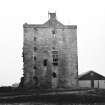
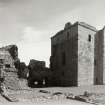

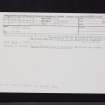
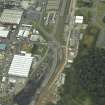
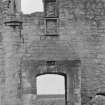

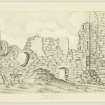

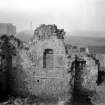

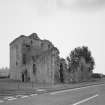
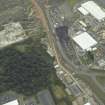
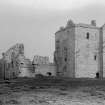
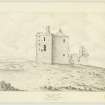
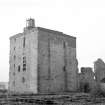
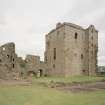
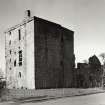
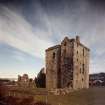
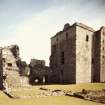
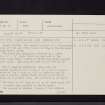
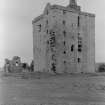


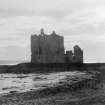
![View of Rosyth Castle on island.
Original envelope annotated by Erskine Beveridge 'Rosyth Cas[tle]'.](http://i.rcahms.gov.uk/canmore/s/SC01129268.jpg)
